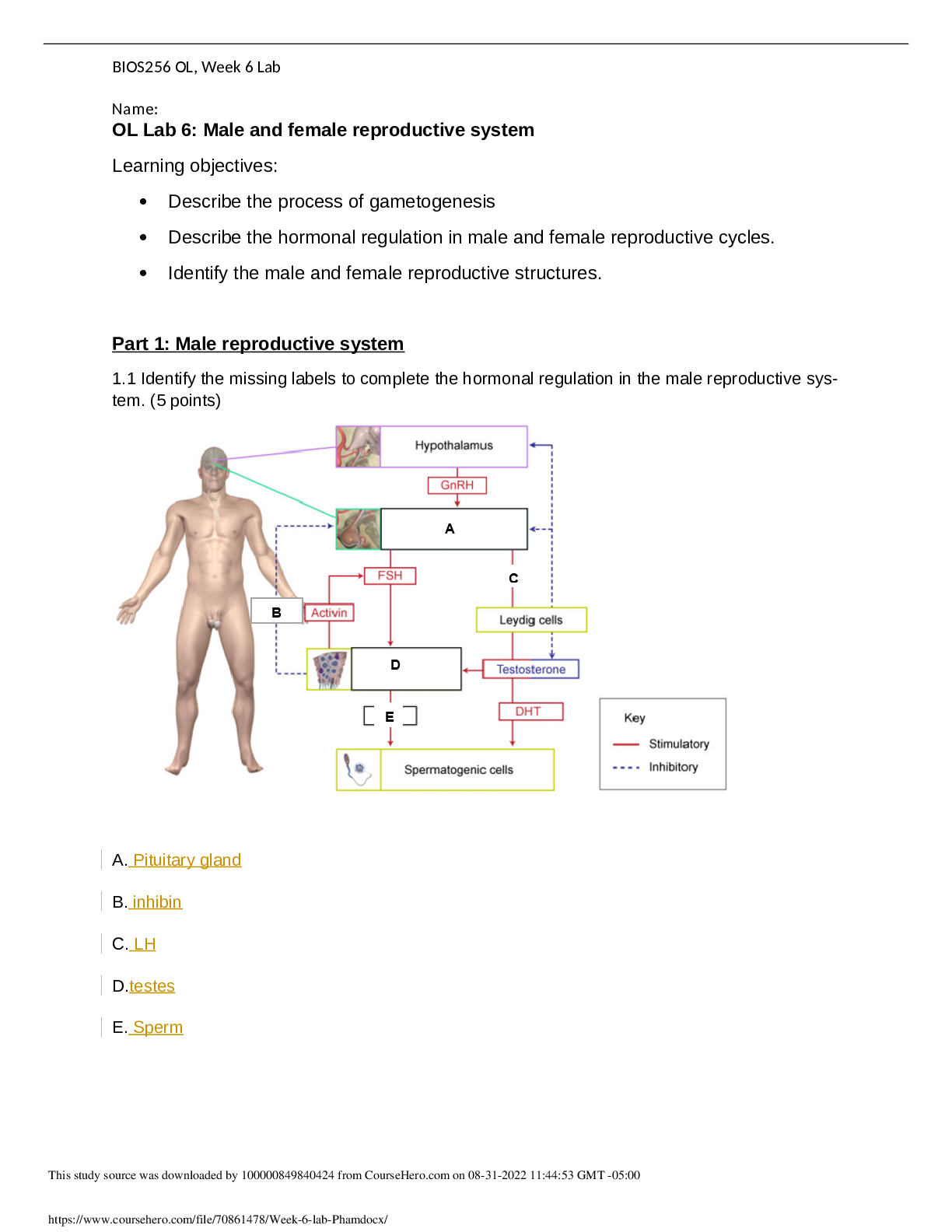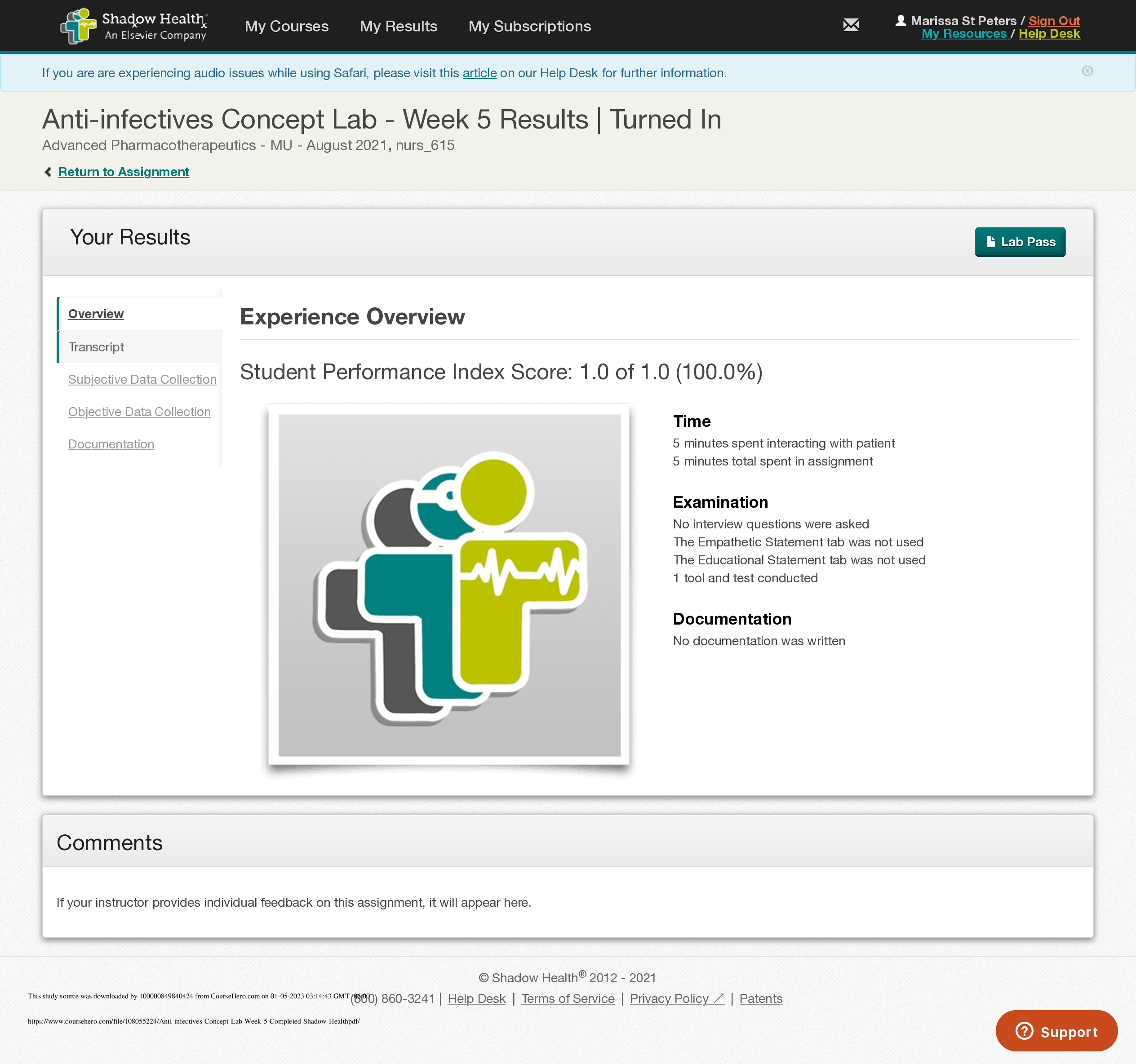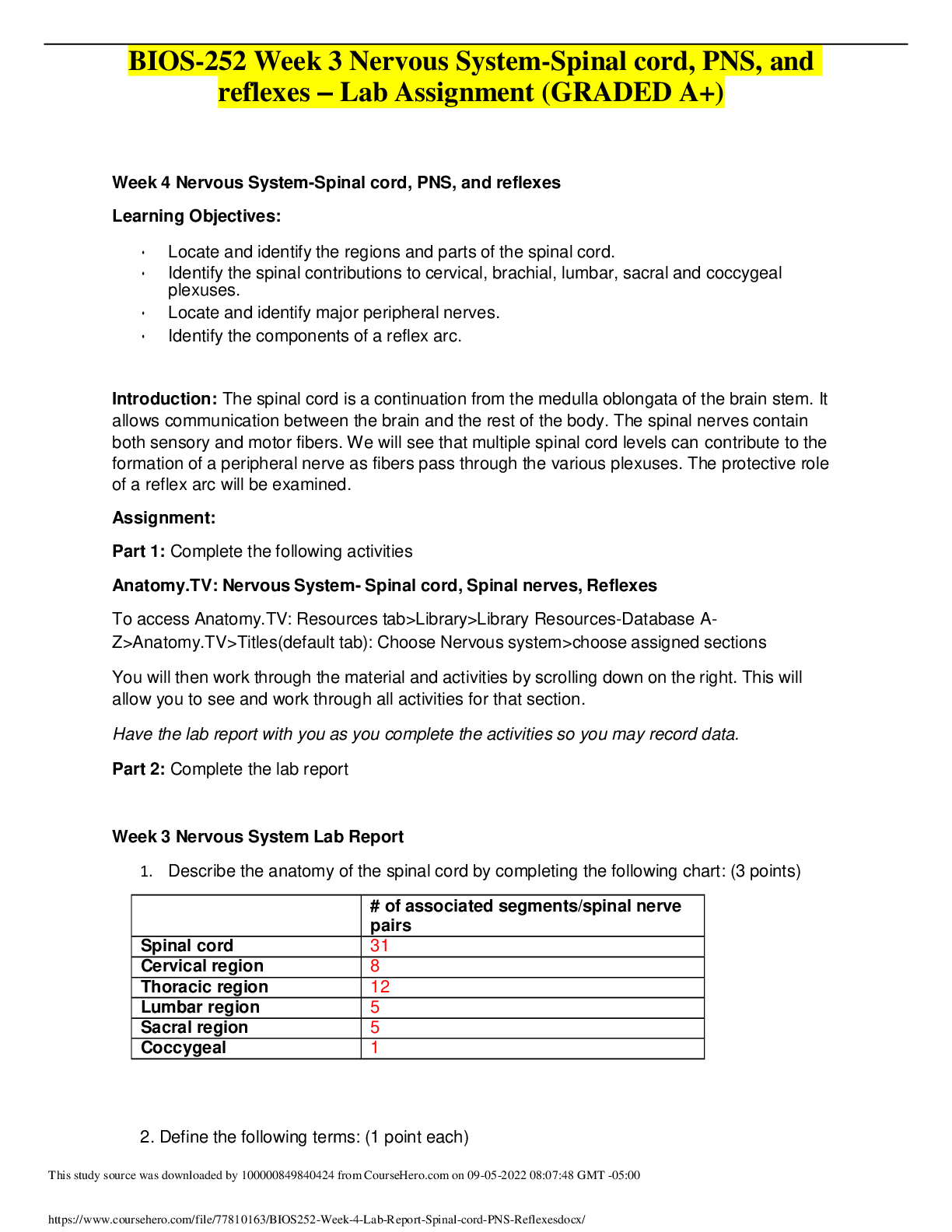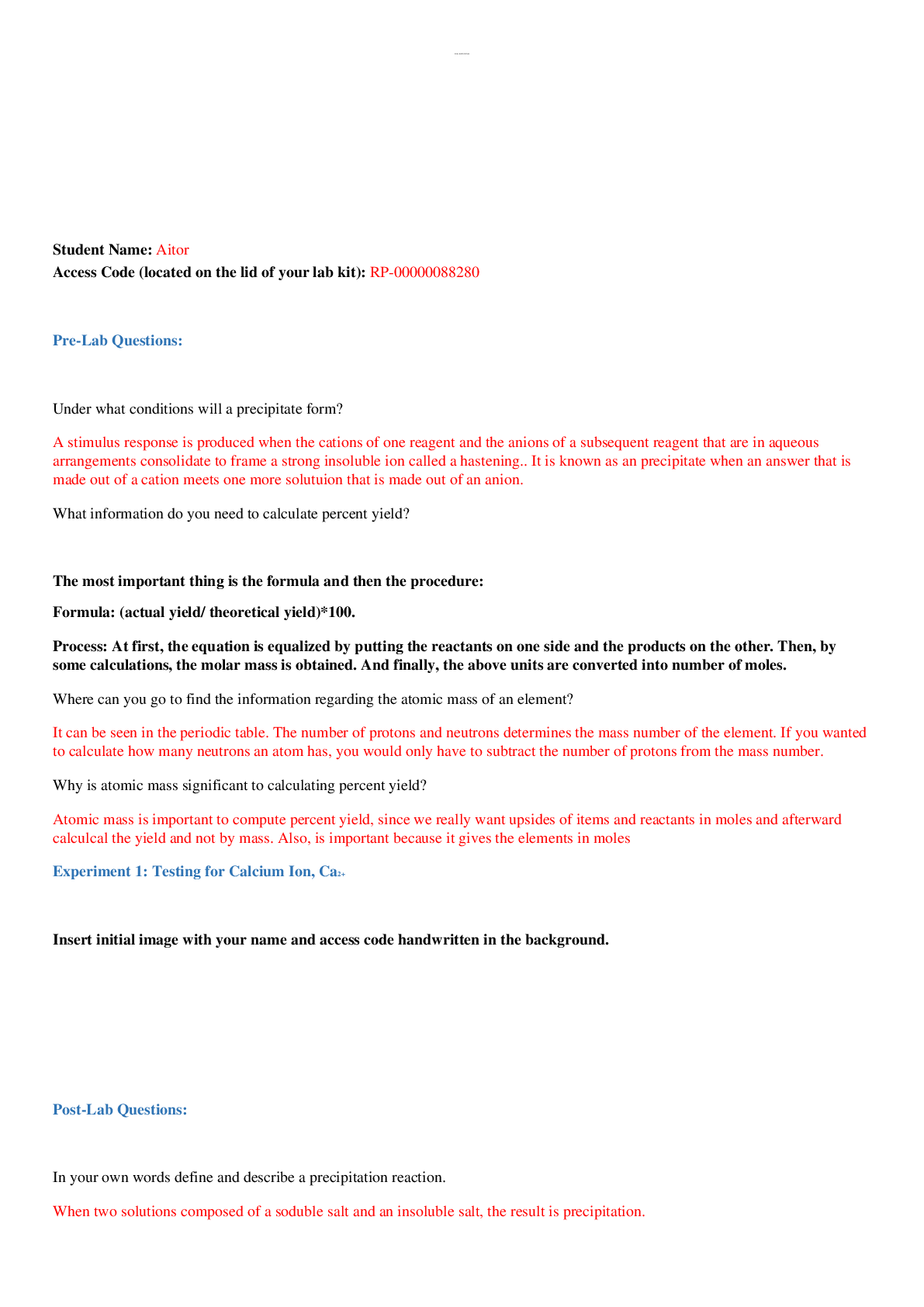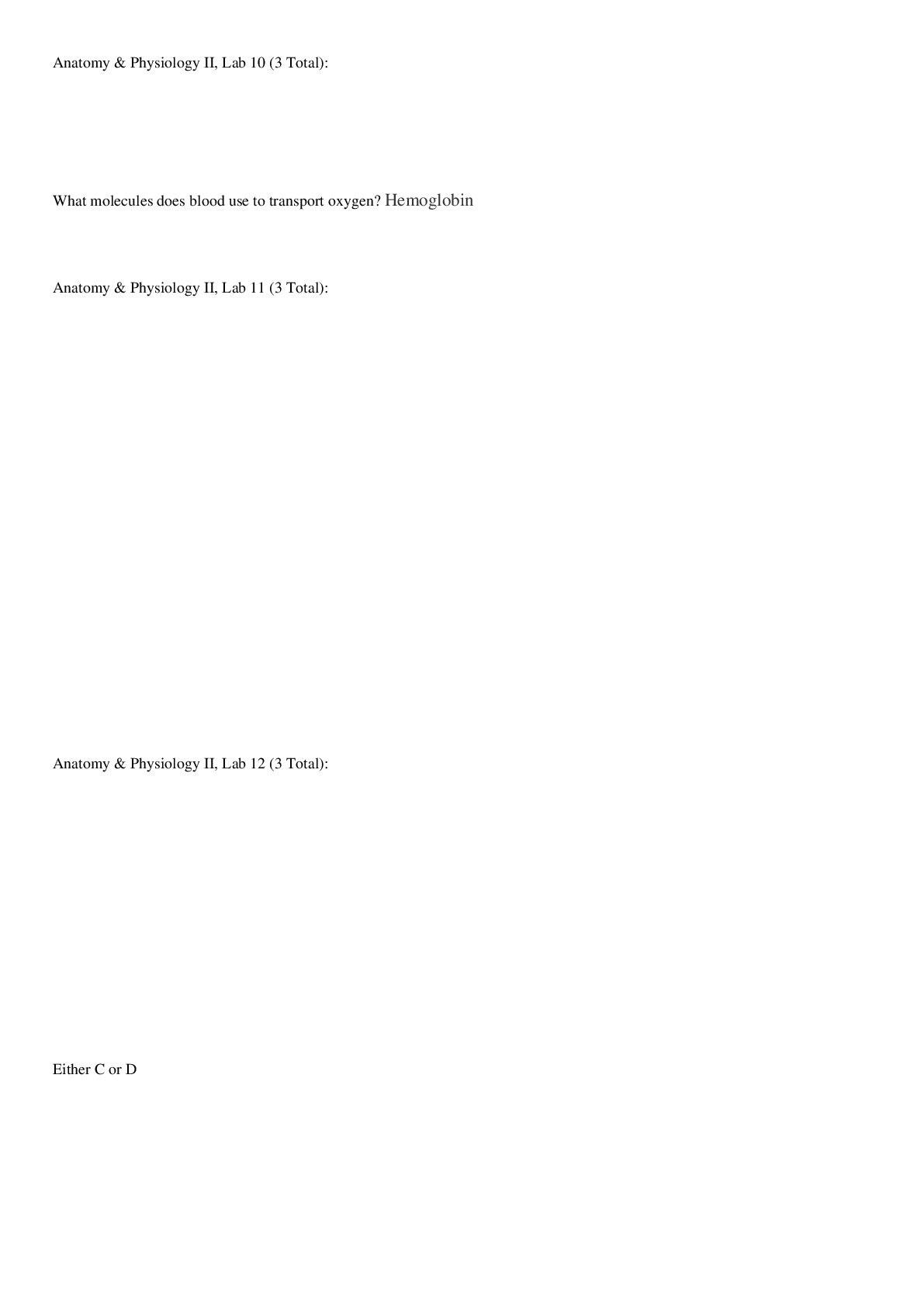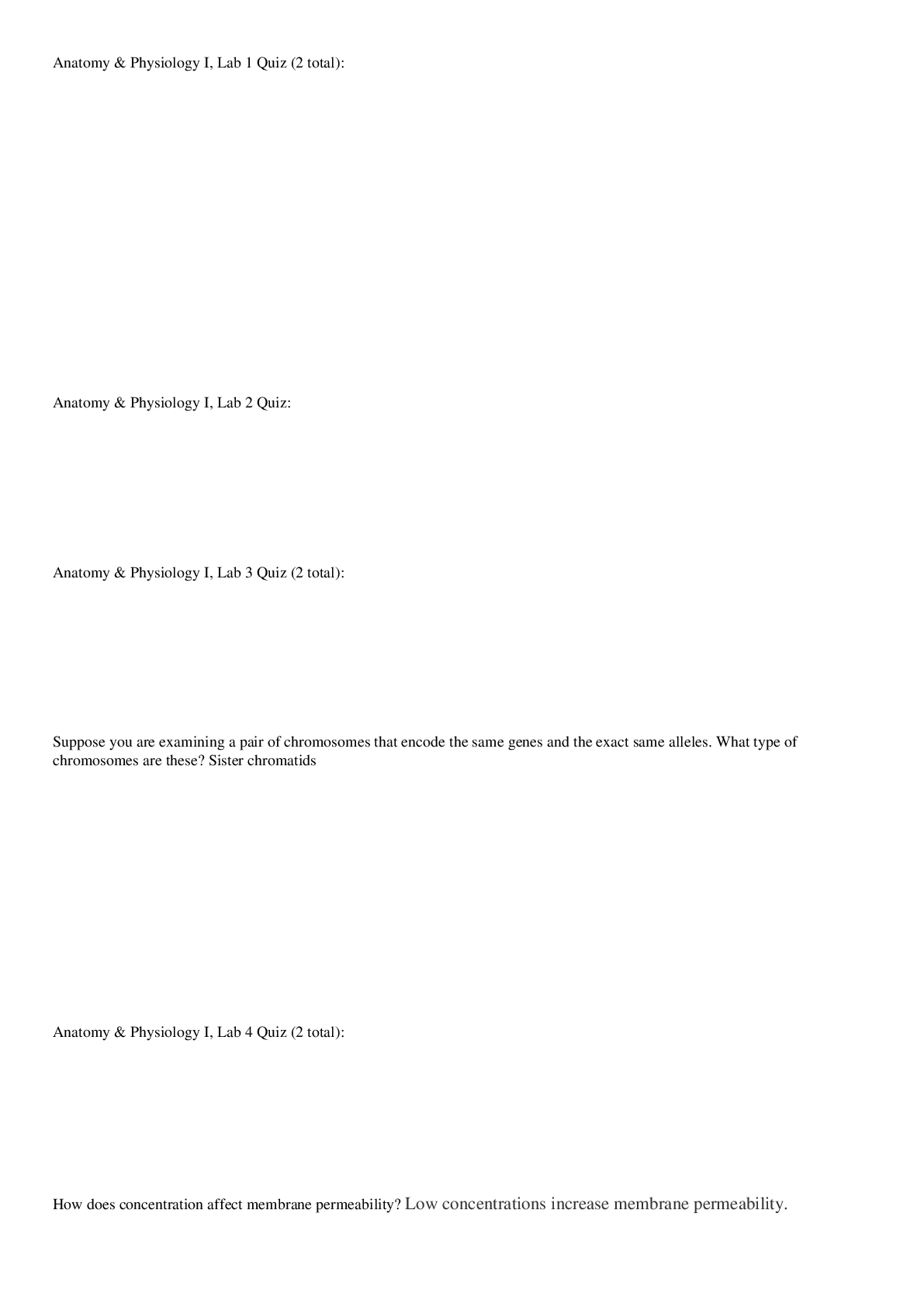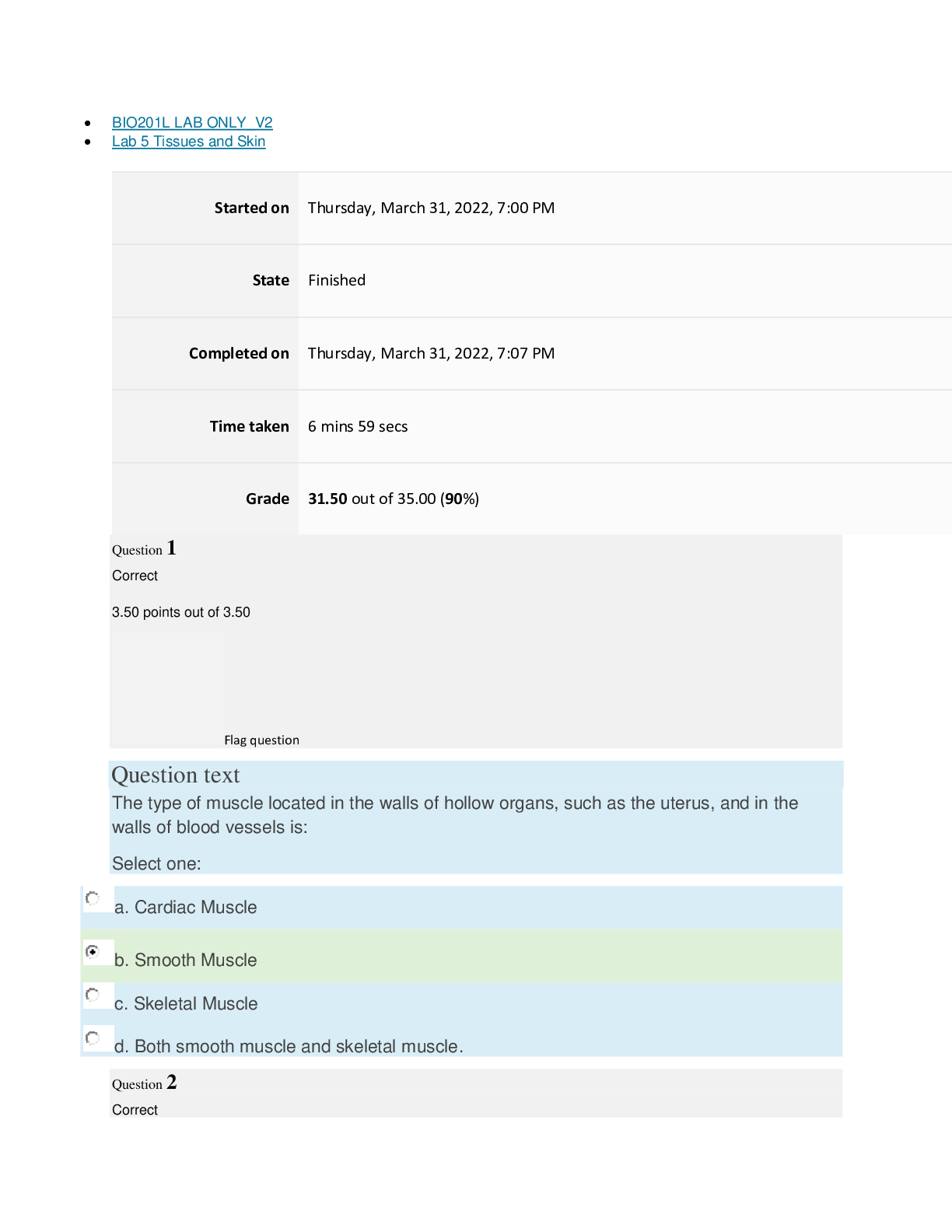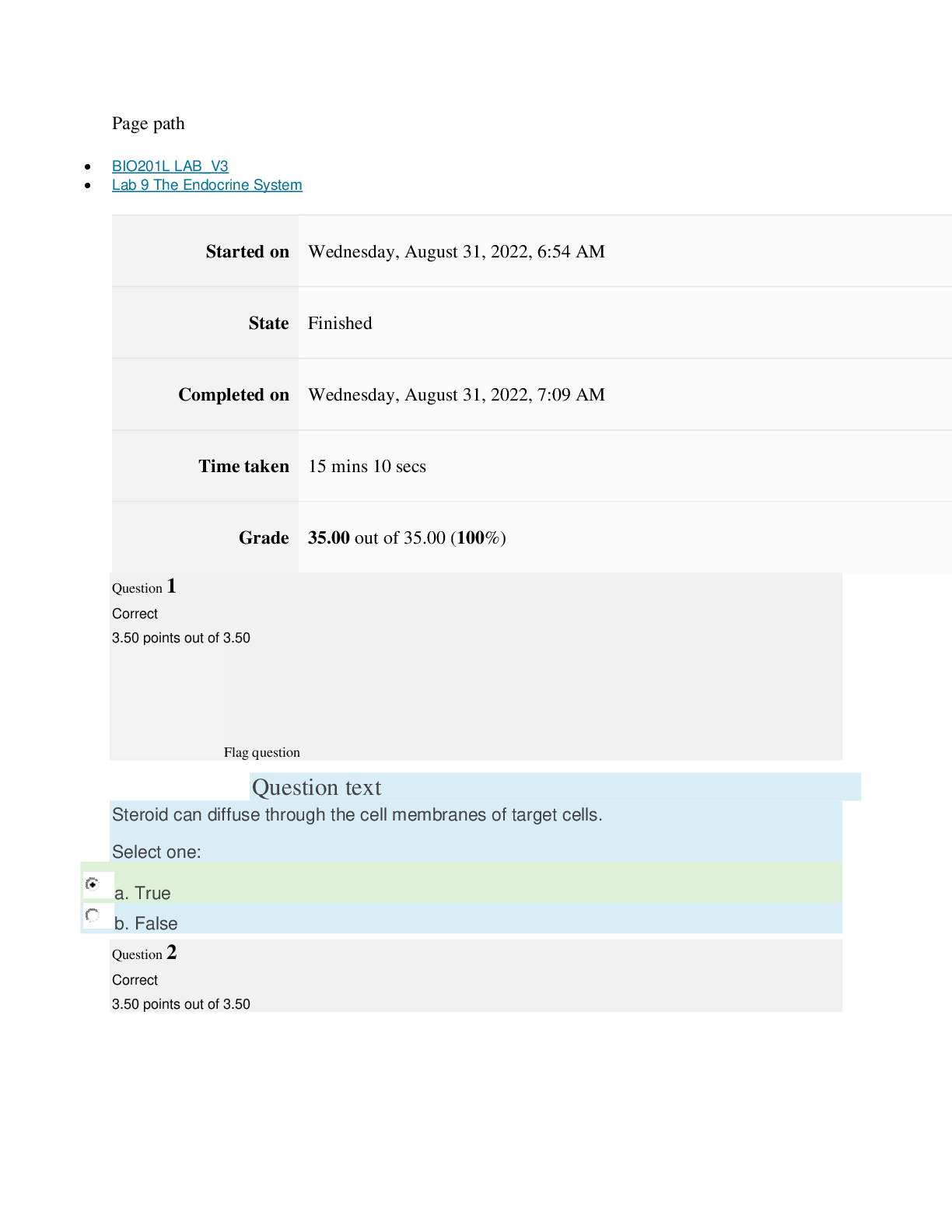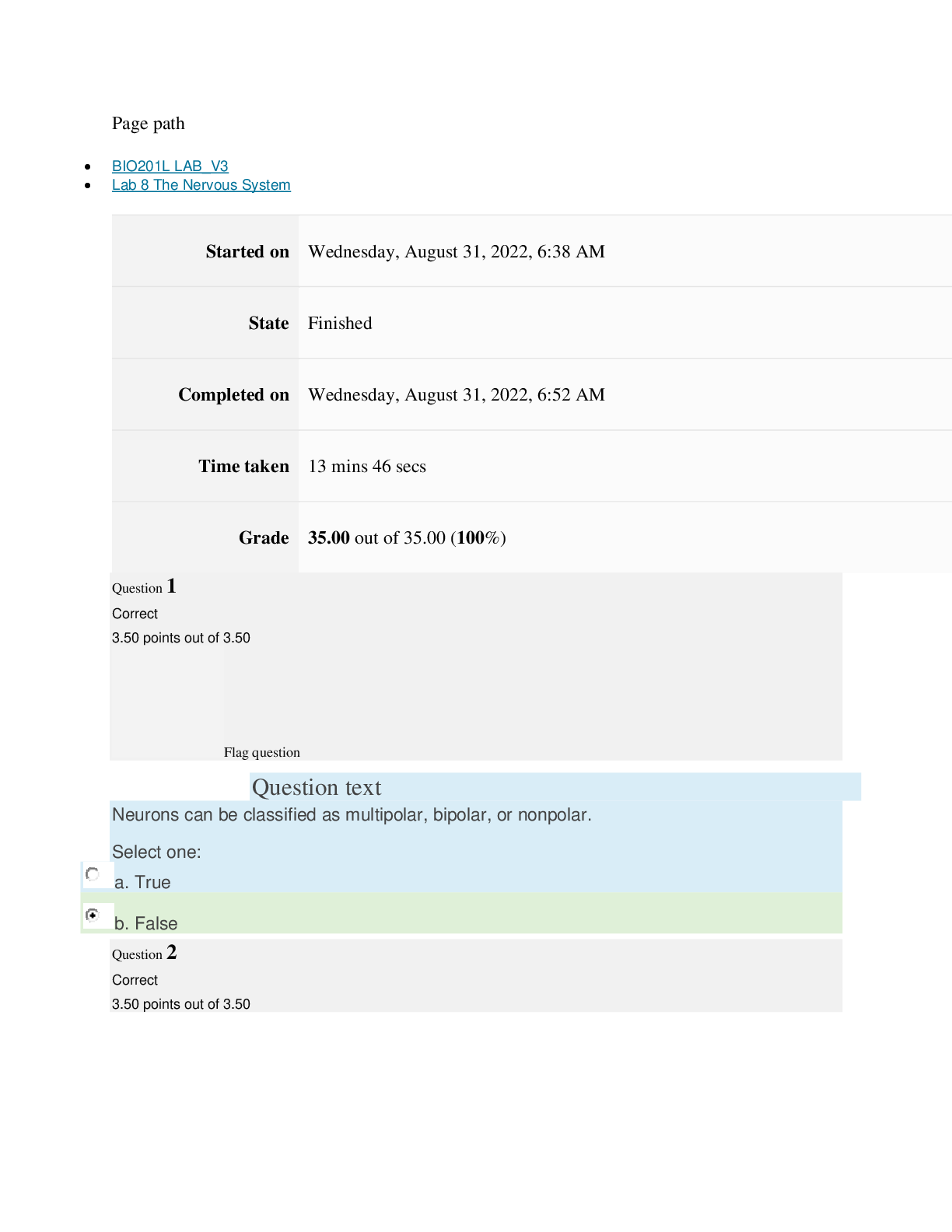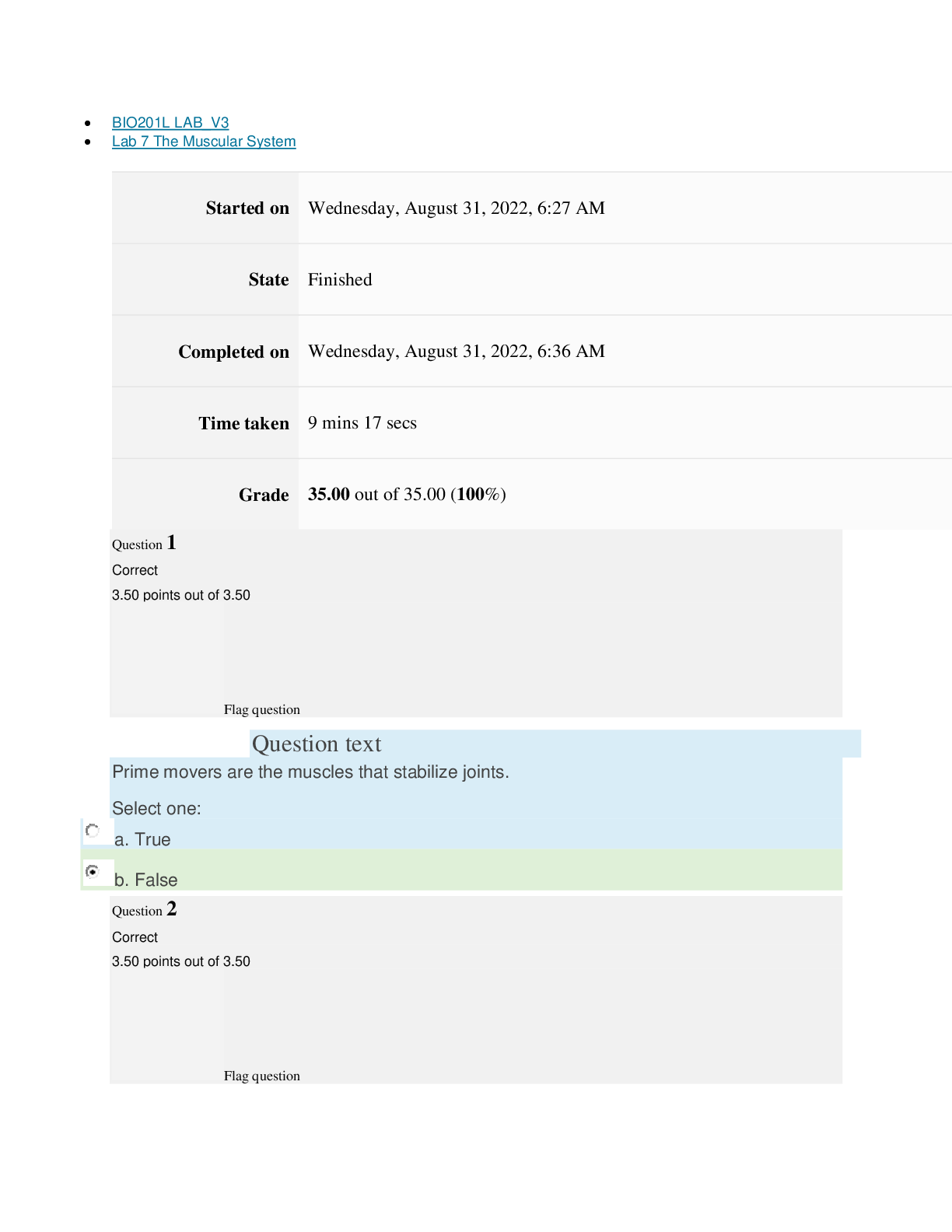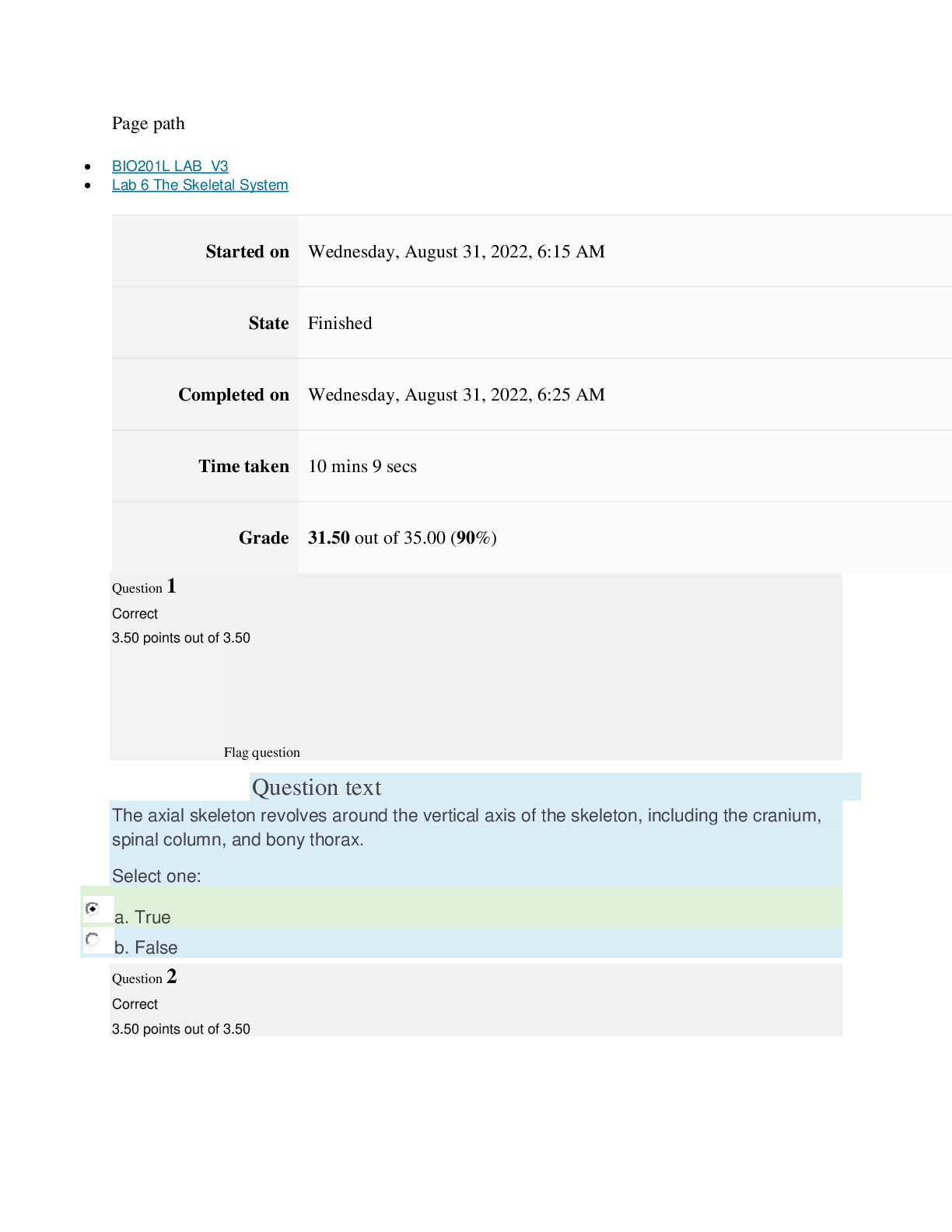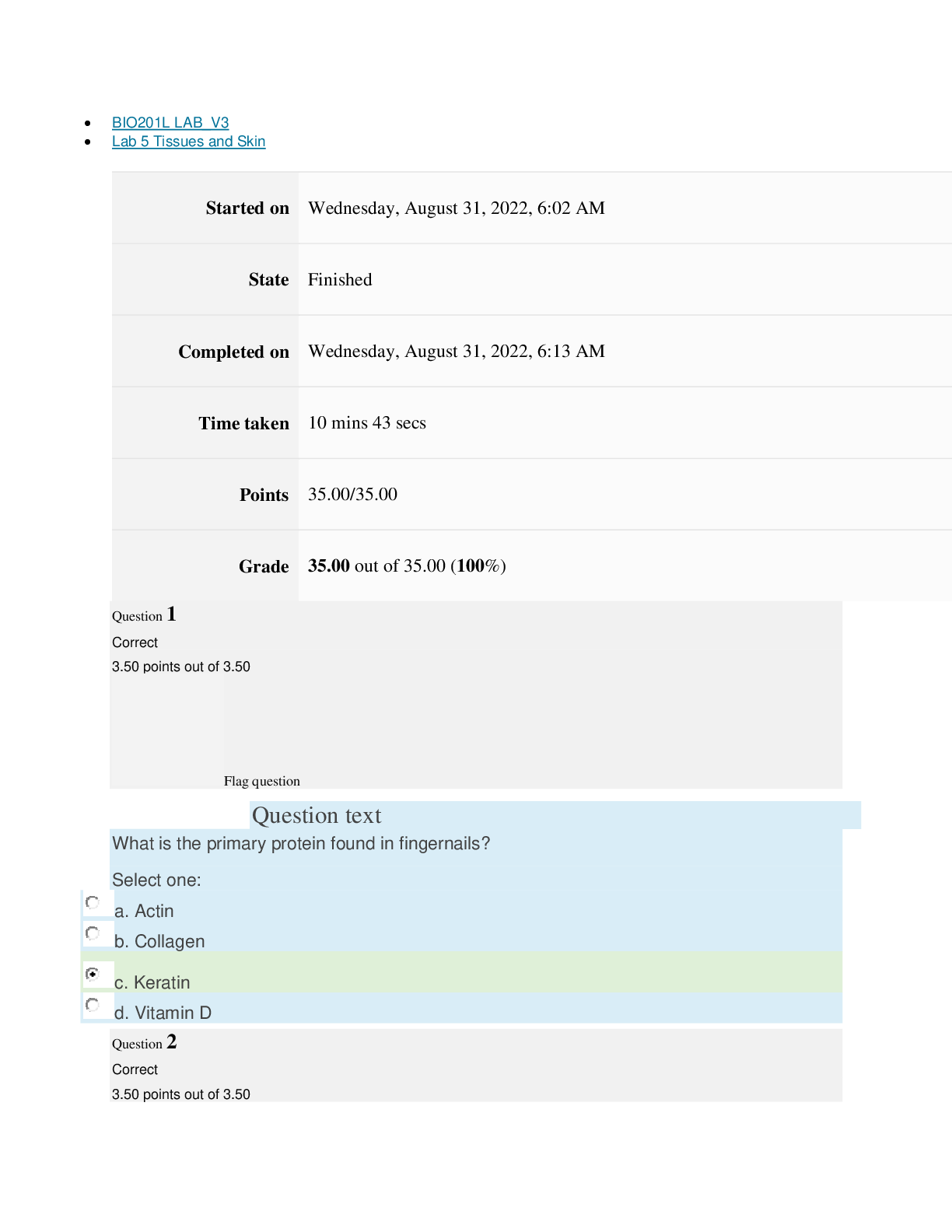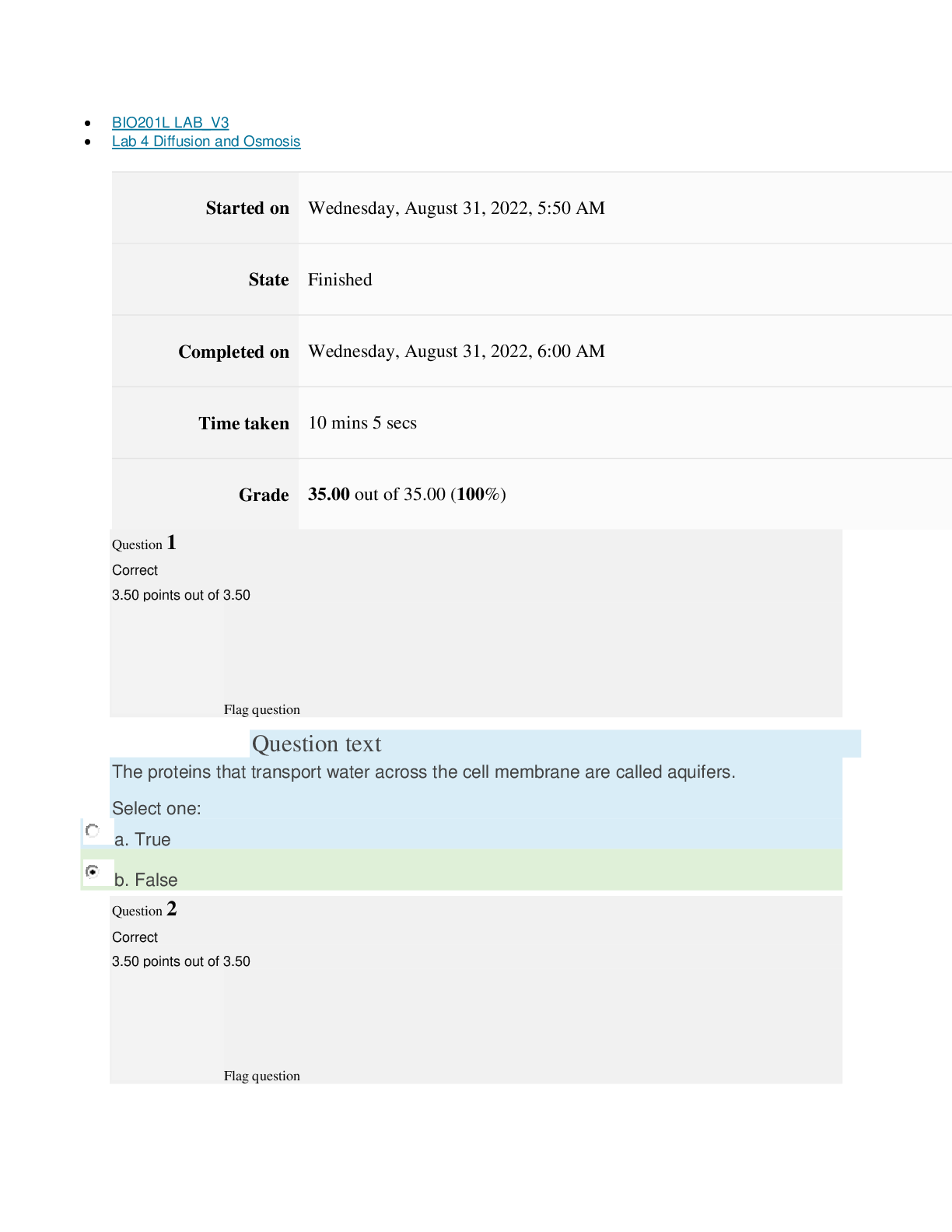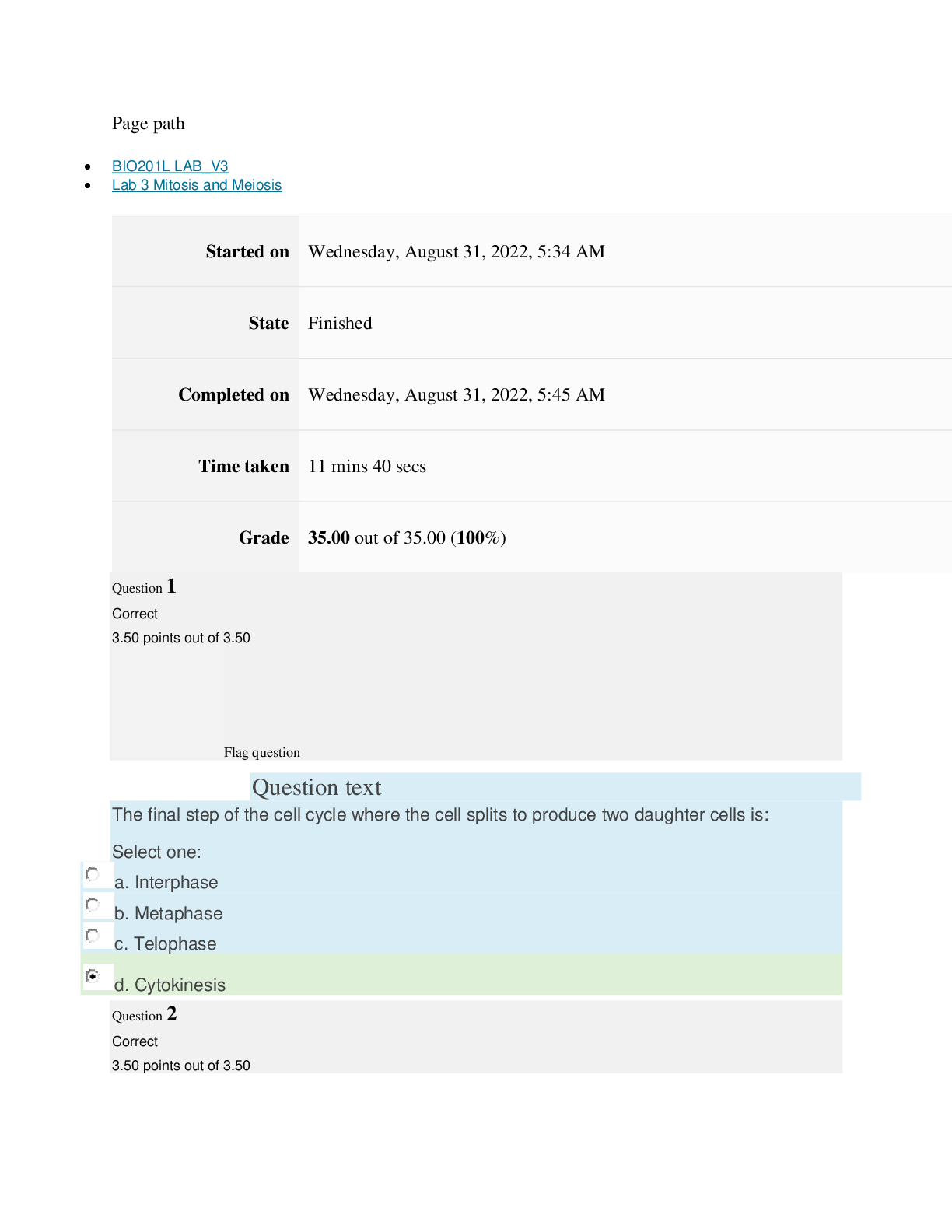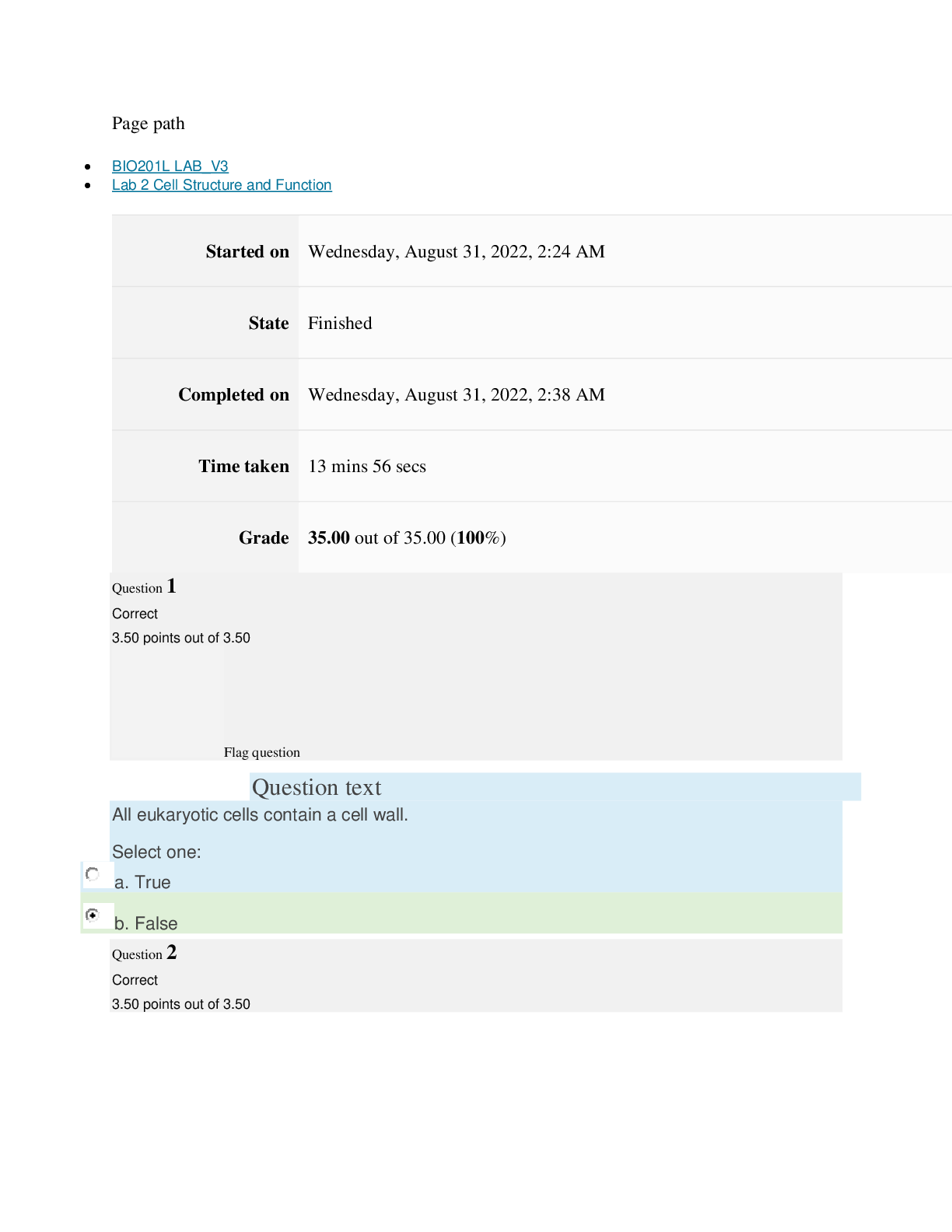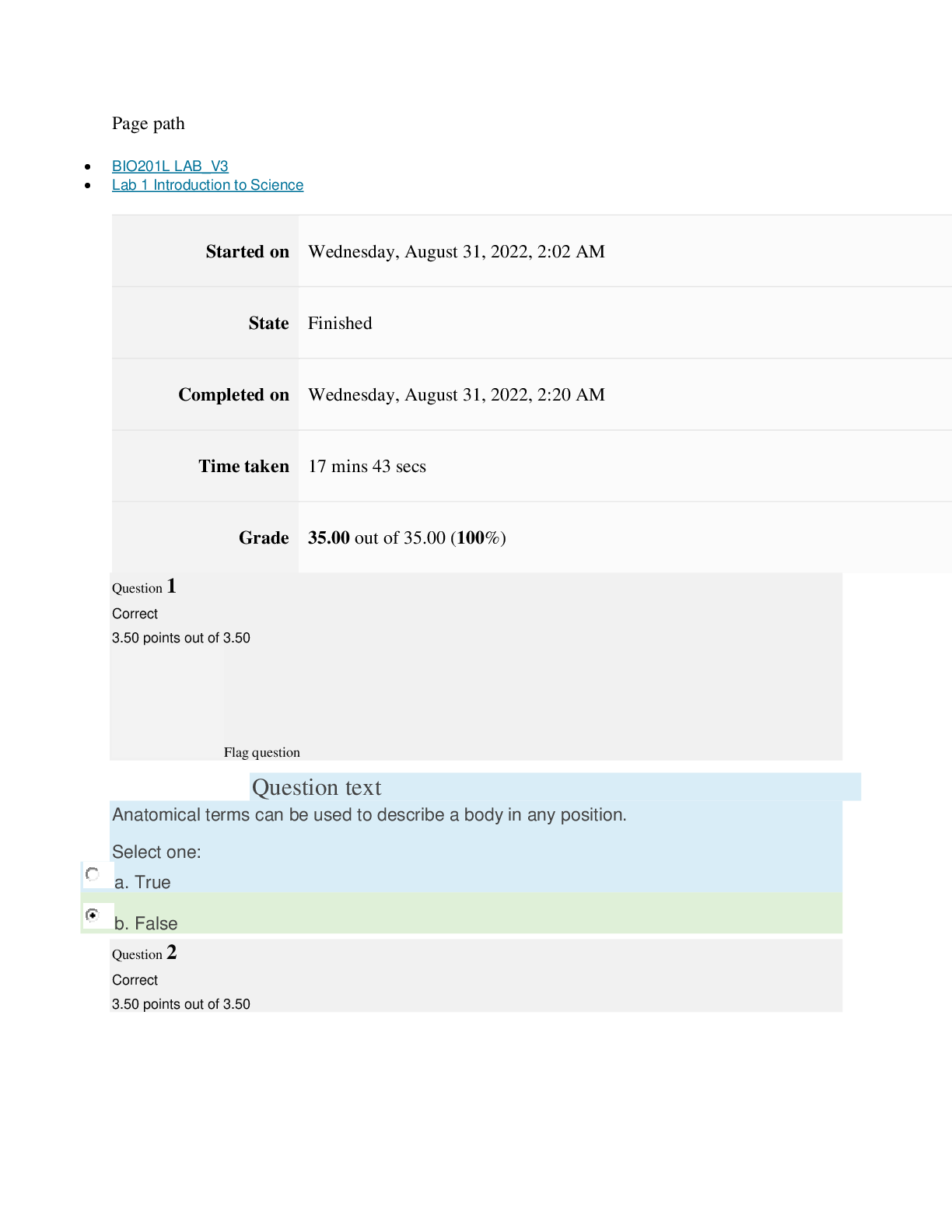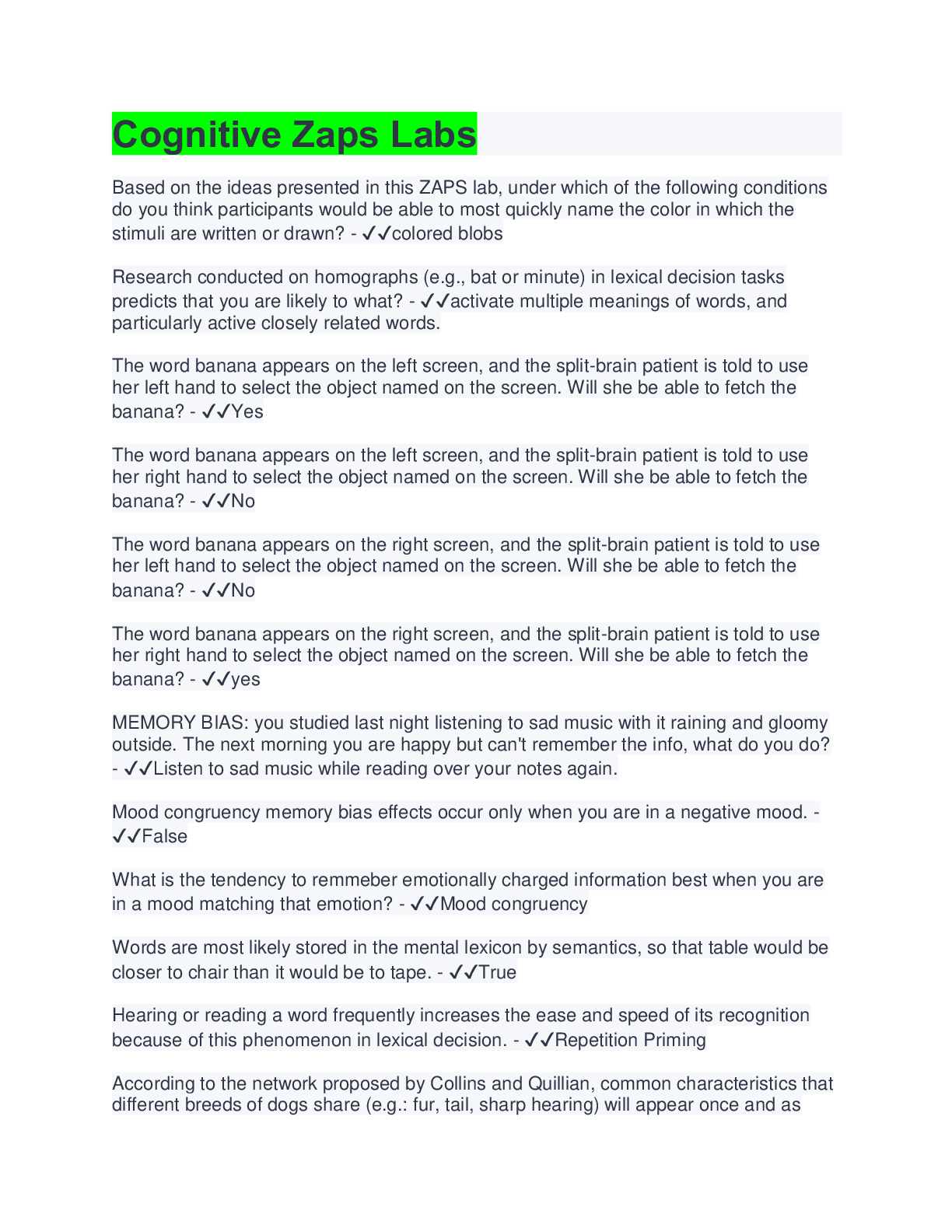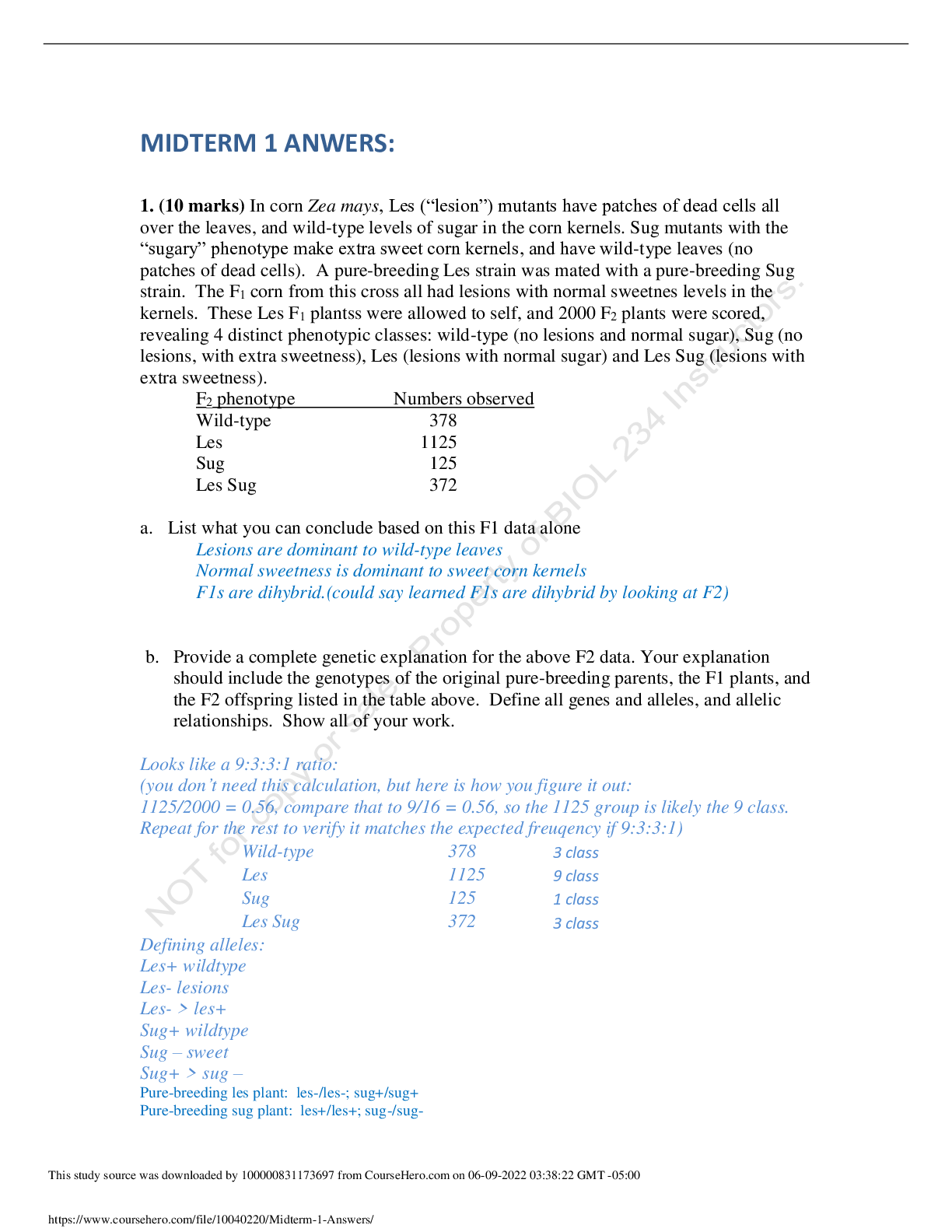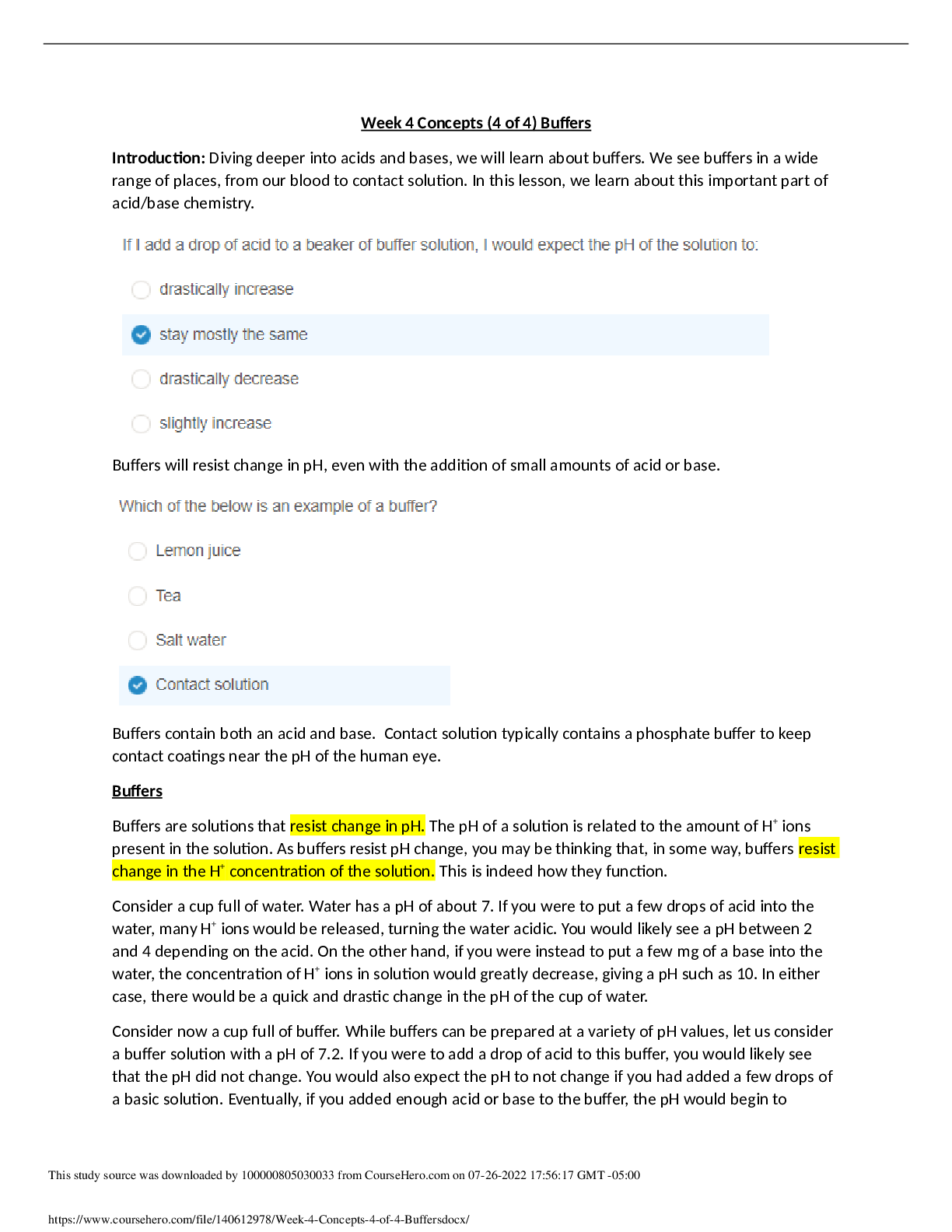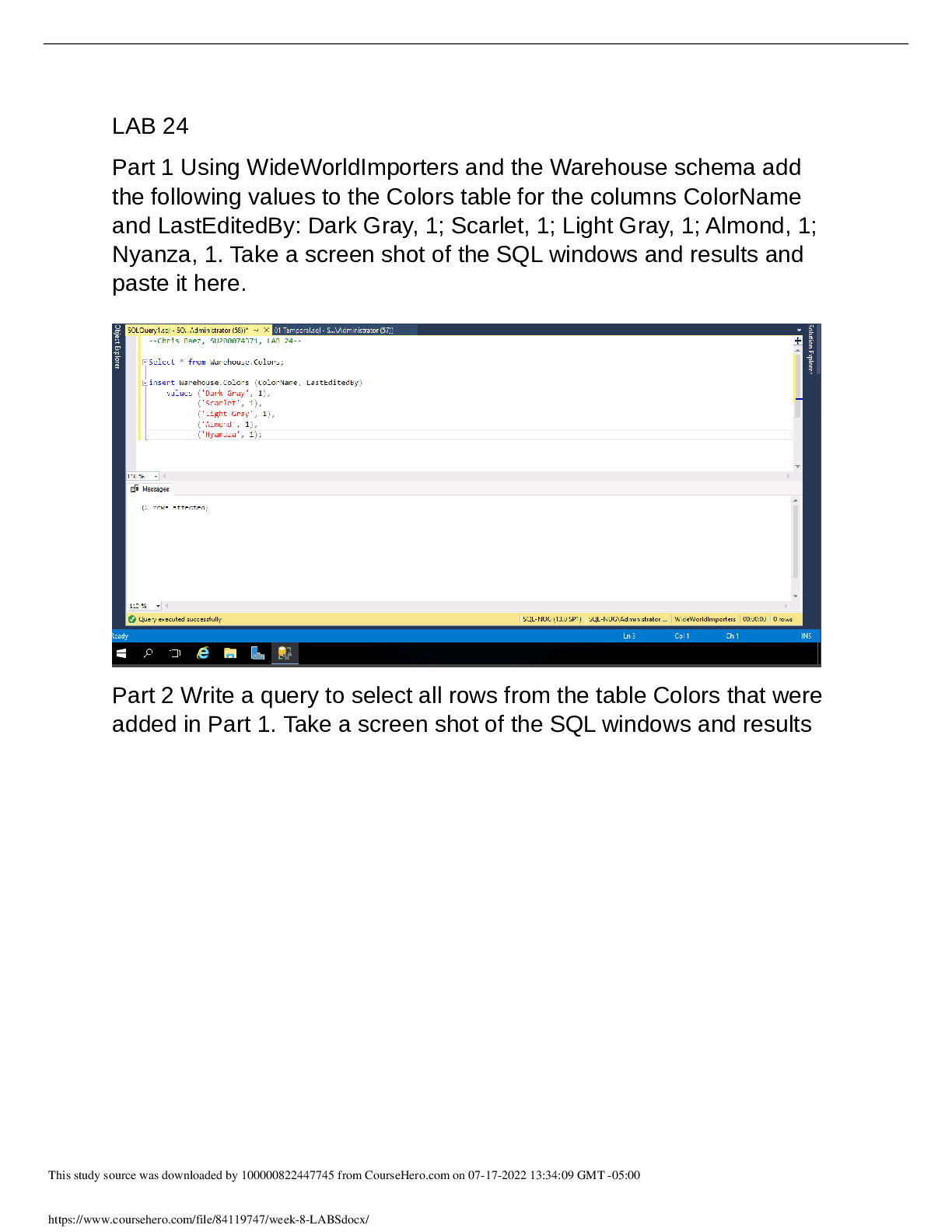Anatomy and Physiology - A&P 2 > LAB QUIZ > BIOS-255 Week 3 Assignment: Cardiovascular System: Blood Vessels (graded) (All)
BIOS-255 Week 3 Assignment: Cardiovascular System: Blood Vessels (graded)
Document Content and Description Below
BIOS255 Week 3 Cardiovascular System: Blood Vessels Learning objectives: • Identify the structural layers of arteries and veins. • Distinguish between the structure of arteries and vein... s. • Explain the factors that affect arterial blood flow and blood pressure. • Define shock, and identify the signs of shock. • Identify key blood vessels of the cardiac, systemic, and pulmonary circulations. Introduction: Blood is transported around the body in 3 different types of blood vessels: arteries, capillaries, and veins. Arteries and veins are each composed of 3 distinct layers of tissue while capillaries only have one layer. Blood pressure and flow depend on multiple factors. There are a number of mechanisms by which shock can occur. We will track blood through the pulmonary and systemic circulations noting the major arteries and veins along the path. Enjoy the interactive 3D models for exploring the blood vessels! Assignment: Part 1 Complete the activities in the following sections of Anatomy.TV Cardiovascular system: Blood vessels, Blood flow and Pressure, Circulatory Pathways, Vessels of the Trunk, Vessels of the Head and Neck, Vessels of the Limbs To access Anatomy.TV: Resources tab>Library>Library Resources-Database A- Z>Anatomy.TV>Titles(default tab): Choose Cardiovascular system>choose assigned sections You will then work through the material and activities by scrolling down on the right. This will allow you to see and work through all activities for that section. As you complete the lab activities, have the lab report ready to record data. Part 2 Complete the lab report. Blood vessel Lab report 1. Describe the different types of blood vessels by completing the following chart: (3 points total; 1/4 point per box) Blood vessel Histological description/special characteristics Function Large arteries They have well defined internal and external elastic laminae, and their tunica media is thick and full or elastic fibers (elastic lamellae), enabling their walls to stretch easily with an increase in blood pressure (high compliance), as seen during systole. They propel blood from the heart during ventricular diastole. Their elastic properties are essential to accommodate the volume of blood created when blood s expelled from the heart. As they stretch, elastic fibers store mechanical energy, which is converted into kinetic energy as the elastic fibers recoil and force the blood away from the heart. Medium arteries They have well-defined internal but thin externa elastic laminae. Depending on the size of the artery, the thick tunica media is made up of 3- 40 concentrically arranged layers of smooth muscle cells. Lack of elastic fibers in the wall of muscular arteries means that recoil does not propel the blood as in elastic arteries. Instead, smooth muscle cells maintain a state of partial contraction of vascular tone, ensuring that vessel pressure and efficient blood flow are sustained and enable efficient adjustment of the rate of blood flow by vasoconstriction and vasodilation. Arterioles Arterioles are also referred to as resistance vessels. They are numerous, microscopic arteries that feed blood into capillary networks. Vessel diameter varies from 15-300 depending on the location; wall thickness is about half the total diameter. Along with local chemical mediators, the sympathetic nerve supply of the arteriole triggers vas Capillaries Capillaries are short, branched, interconnecting vessels that form networks within nearly every structure of the body, bridging the gap between arterioles and venules. A microcirculation exists as blood flows from a metarteriole, through capillaries, into a postcapillary venule. Capillary networks provide a large surface area in contact with tissues throughout the body. Medium veins Medium veins have al three layers of a typical blood vessel; the tunic externa is the thickest layer, consisting of collagen and elastic fibers; the tunica media, lacking in smooth muscle and elastic fibers, is thin along with the tunica interna. They do not have internal or elastic laminae and therefore are not able to withstand high pressure. The valves function to boost venous return by preventing back flow of blood due to gravity. Large veins Large veins have a thick tunica externa, similar to that of medium veins, but they lack valves. Large veins drain from their tributaries into the heart. 2. When a fall in arterial pressure is detected by baroreceptors, how does the cardiovascular center alter the parasympathetic and sympathetic stimulation of the sinoatrial (SA) node to maintain homeostasis? (1 point) A sudden increase in blood pressure stretches the baroreceptors and the increased firing results in the vasomotor center inhibiting sympathetic drive and increasing vagal tone on the SA node of the heart. The SA node is slowed by the acetylcholine and heart rate slows to correct the increase in pressure. 3. Describe the signs and symptoms of shock as described under Blood Flow and Pressure: Shock and Homeostasis. (1 point) The typical signs of shock are low blood pressure, a rapid heartbeat, and signs of poor end- organ perfusion or decompensation (such as low urine output, confusion, or loss of consciousness). In some people with circulatory shock, blood pressure remains stable 4. Identify the missing arteries from the schematic. (2.5 points; 1/2 point each) 5. Identify the missing arteries from the schematic: (3 points total; ¼ point each) 6. Trace a drop of blood from the heart to the top of the foot by naming the blood vessels from the aorta to the artery that can be felt on the top of the foot (dorsalis pedis artery). (2 points) Heart to Foot: Ascending aorta > Arch > Thoracic aorta > Descending aorta > R&L Common iliac a > R&L External iliac a > R&L Femoral > R&L Popliteal > R&L Anterior & posterior tibial > R&L arches 7. Trace a drop of blood from the superior mesenteric vein within the abdomen to the right atrium. Include the major vessels along the path. (1.5 points) Superior mesenteric vein drains blood majorly from small intestine. It also drains some amount of blood from large intestine and stomach. The superior mesenteric vein combines with splenic vein and drains into hepatic portal vein which it is received by the liver. From liver hepatic veins arise which further drains into inferior vena cava. The inferior vena cava ultimately drains the blood into the right atrium. 8. a. What is a portal system? (½ point) A portal system is an arrangement by which blood collected from one set of capillaries passes through a large vessel or vessels, to another set of capillaries before returning to the systemic circulation. b. What is the function of the hepatic portal system? (½ point) The hepatic portal system is the venous system that returns blood from the digestive tract and spleen to the liver (where raw nutrients in blood are processed before the blood returns to the heart) Grading Rubric for Lab Report Activity Deliverable Points Part 1 Complete lab activities 15 Part 2 Complete lab report 15 Total Complete all lab activities 30 [Show More]
Last updated: 1 year ago
Preview 1 out of 6 pages

Reviews( 0 )
Document information
Connected school, study & course
About the document
Uploaded On
Oct 26, 2022
Number of pages
6
Written in
Additional information
This document has been written for:
Uploaded
Oct 26, 2022
Downloads
0
Views
74
.png)

.png)


.png)

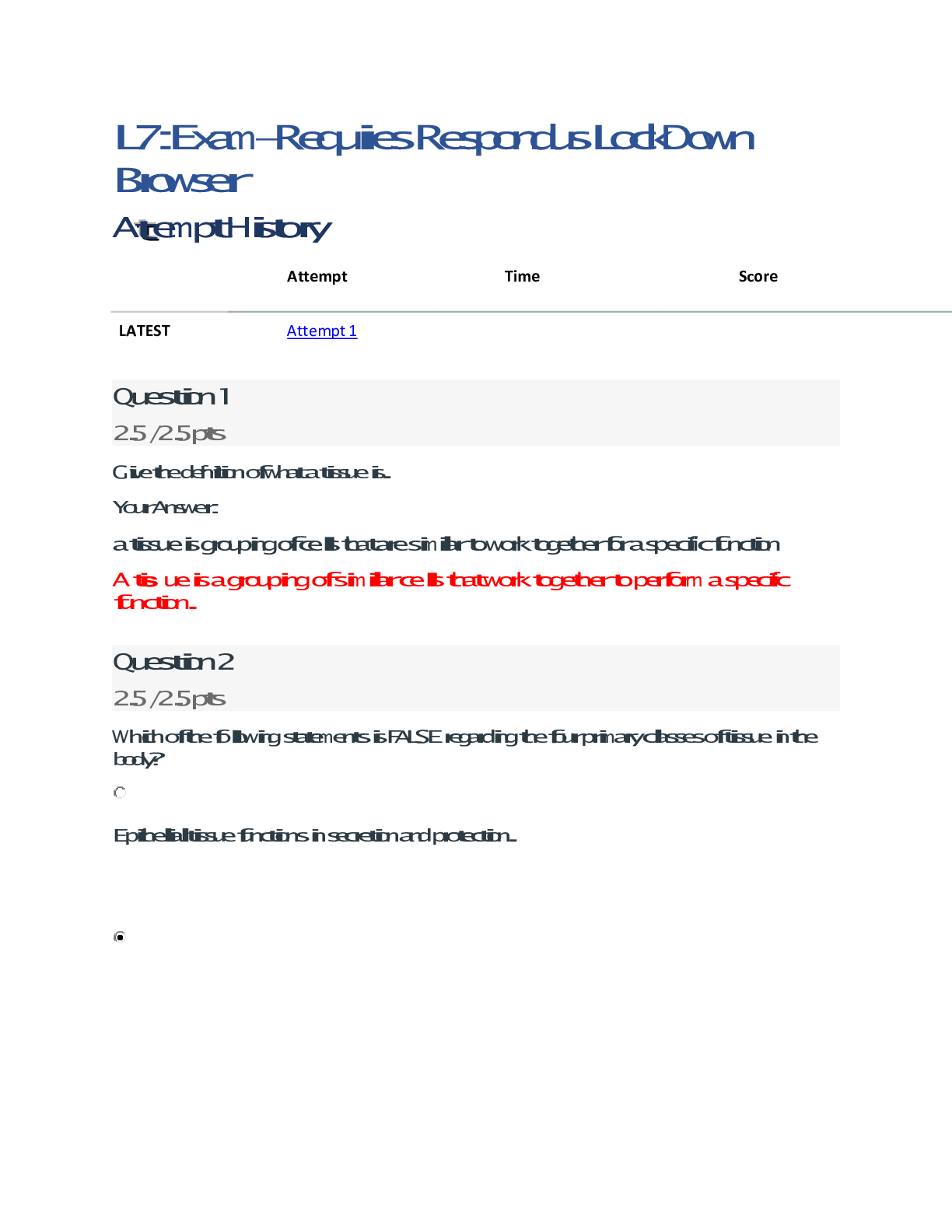
.png)
.png)
 (1).png)
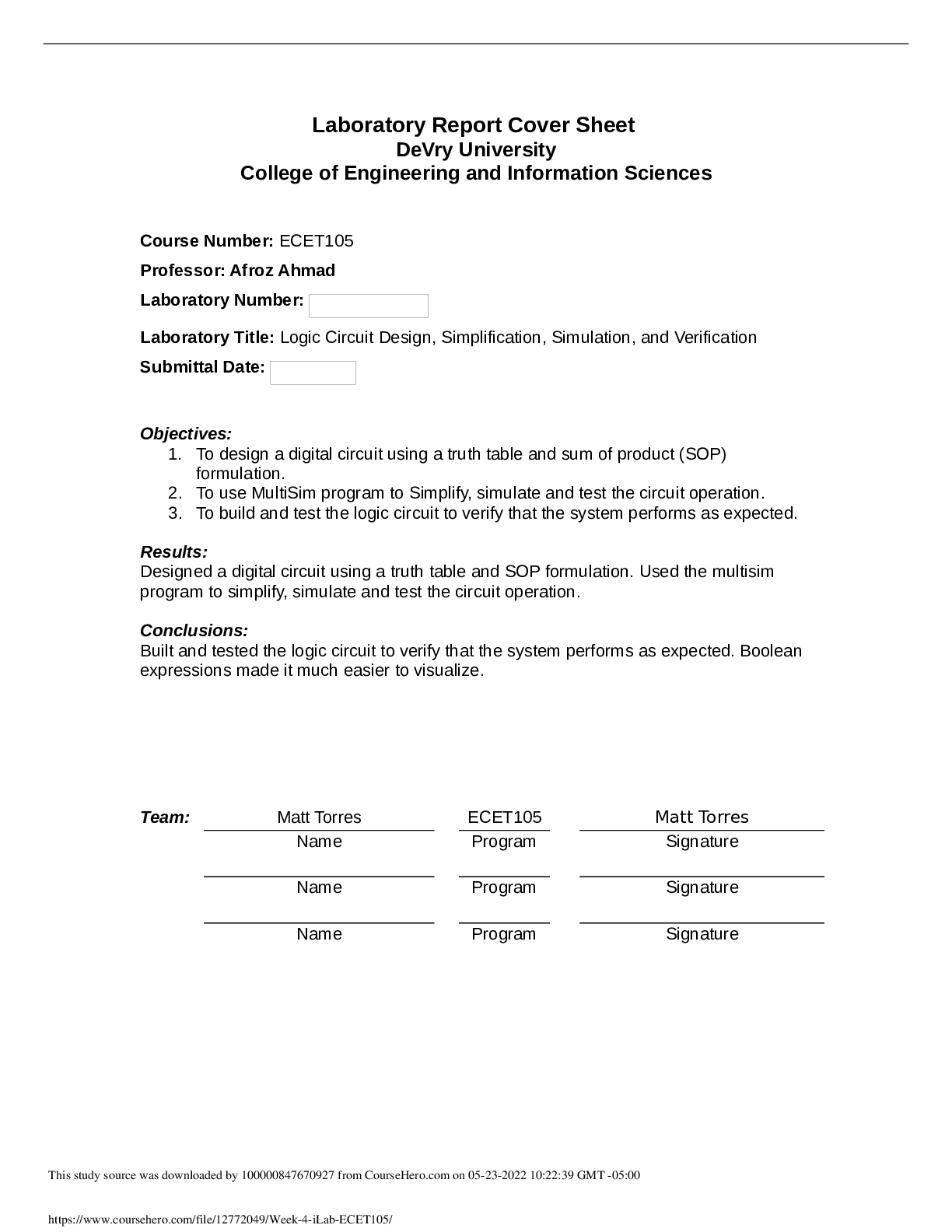
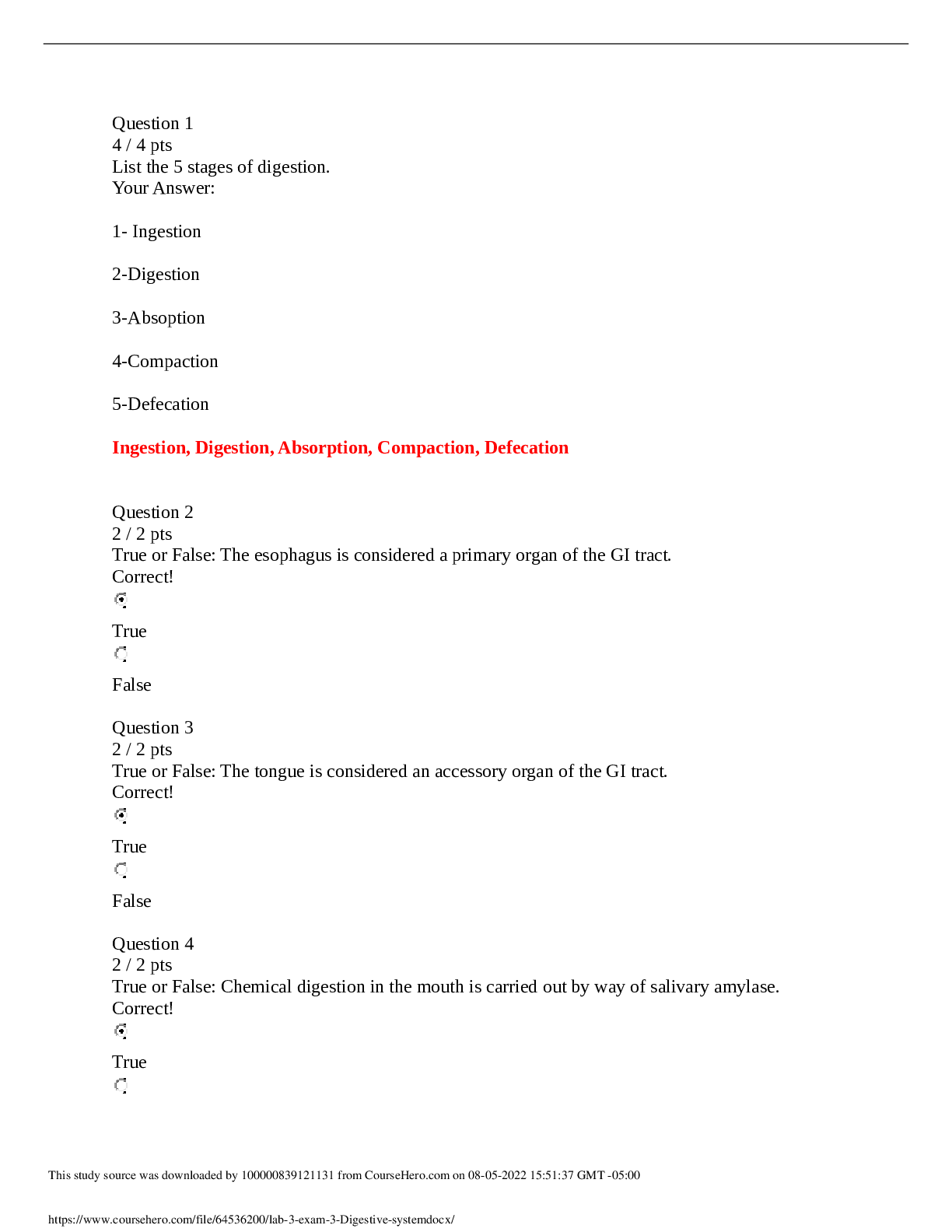
.png)
